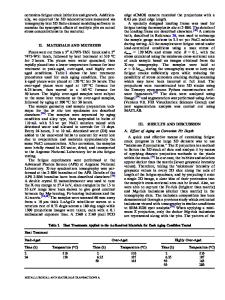Theoretical Considerations on Corrosion Fatigue Crack Initiation
- PDF / 596,375 Bytes
- 7 Pages / 594 x 774 pts Page_size
- 54 Downloads / 504 Views
I.
INTRODUCTION
2. Assumptions
IT is
well known that under corrosion fatigue conditions, both the fatigue life and the fatigue limit can be lowered considerably. Laboratory tests and service experience show that a fatigue limit is no longer existent, if pitting or crevice corrosion occurs. The fatigue life of a defect-free component or specimen can be split into two phases: crack initiation and crack propagation. Fatigue crack propagation life can be calculated by fracture mechanics. It is known that the influence of corrosion on crack growth is much less than on crack initiation, if stress corrosion cracking or hydrogen embrittlement is excluded. Corrosive media increase crack propagation rates not more than by a factor of three to five.l Since corrosion can have a pronounced influence on crack initiation, this work is mainly concerned with corrosion fatigue crack initiation. Theoretical considerations are made for three different corrosion conditions: 9 general corrosion 9 localized corrosion (pitting) 9 passive corrosion Finally, the theoretical calculations are compared with results of laboratory corrosion fatigue tests.
H.
DERIVATION OF CORROSION FATIGUE INITIATION L I F E T I M E
A. General Corrosion 1. Model During fatigue loading general corrosion leads to a decrease of the loaded cross section. Therefore, the effective stress range will increase with time, leading to an earlier crack initiation than in air. Thus, the corrosion fatigue/ini tiation life is determined by the corrosion rate RK and the applied stress range Atro. M. M O L L E R , formerly Research Engineer with Brown Boveri Research Center, Baden, Switzerland, is now with the Department of Metallurgical Engineering and Materials Science, Carnegie-Mellon University, Pittsburgh, PA 15213. Manuscript submitted April 15, 1981. METALLURGICAL TRANSACTIONS A
9
9 9 9 9
constant corrosion rate, dRK/dt = 0 constant alternating load, d A P / d t = 0 constant loading frequency dv/dt = 0 the material has a fatigue limit in air
3. Life Time Function Fatigue crack initiation in air as well as under general corrosion conditions can be described by damage accumulation. The damage per load cycle is defined as
dN dS = - -
[1]
&
where Ny is the number of cycles to failure. When failure occurs after NI cycles, the sum of the accumulated damage S equals the value of 1. Taking fatigue crack initiation as the failure criterion, with Ns = Ni, the damage accumulation function is defined as =
1
fN~ dN
'o N/-~-o" )
[2]
Ni (Ao') is the function describing the crack initiation S-Ncurve in air. A good approximation for Ni(Ao-) is Ni(A~) = C1" Act ~
Acr>ACrA
Ni(ao)
ao~_&rA
= ~
[3]
ACrA represents the air fatigue limit. For life time calculations under active, general corrosion attack, two different cases exist. 3.a. AO'o>AcrA As above mentioned, at a constant c3,clic load, the effective stress range Act is increased by a decreasing cross section. Considering a circular cross section with radius r0, the time dependent stress range is J Act(t) = Atro[ 1
Data Loading...











